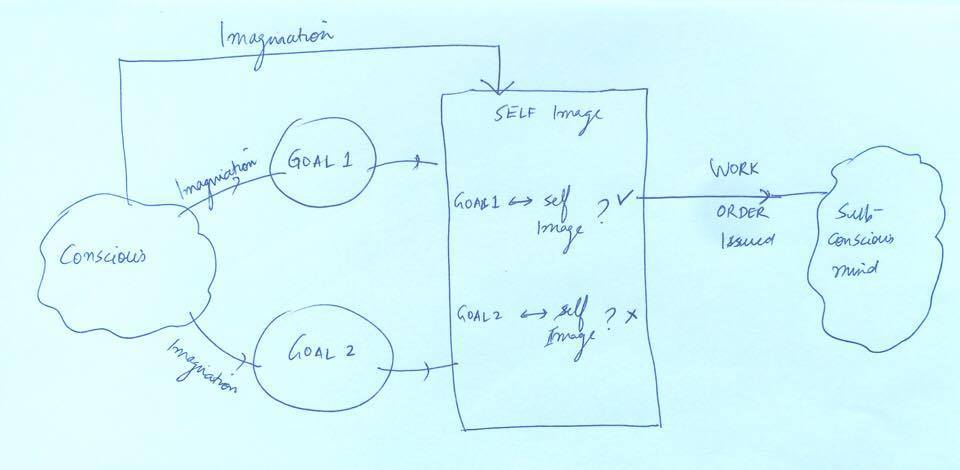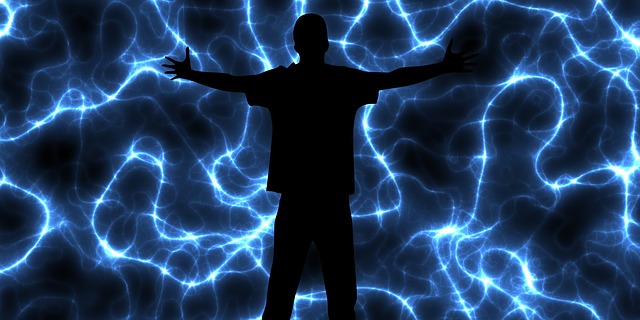Psycho-Cybernetics by Maxwell Maltz | Book Summary and PDF
In the Psycho Cybernetics PDF summary you will learn:
- The role of self-image in the accomplishment of goals
- How to tap the automatic success mechanism within you
- How to harness your own control mechanism
- How to keep the Psycho Cybernetic mechanism working within and for you
Psycho-Cybernetics is probably one of the greatest books ever written on the subject of setting and achieving goals, mind programming, understanding the subconscious and the conscious mind, and self-image. Here’s a summary of fundamental ideas from the book.
1) The Power of Self-Image/Identity

Self-image is the key to living a life without limits.
Key points:
- The creative mechanism (psycho-cybernetics) within us is impersonal.
- Psycho-cybernetics = our mind + the concept of cybernetics (a term used in rocket science)
- Cybernetics – a goal-seeking mechanism in which it locks itself on a target and gets itself towards that goal.
- Psycho-cybernetics is that same mechanism within ourselves.
- Psycho-cybernetics = our mind + the concept of cybernetics (a term used in rocket science)
- Once our psycho-cybernetics has the goal —
- It becomes locked and loaded and will get there.
- It does not care about what goal we set. It works automatically towards the target, whether it is a success goal (e.g. $100 million) or a failure goal (e.g. $1 or being broke).
- Self-image is the secret mental blueprint of ourselves within us.
- It does whatever it has been programmed to do.
- It’s a result of our past, including:
- our failures and successes
- our trials and triumphs
- our tribulations, etc.
- It gets imprinted on ourselves as a result of the following:
- some authority figure telling us something
- how we intensely repeat something to ourselves
- how we repetitively think of ourselves
- It is what we become.
- Our actions, or lack of it, and whatever we think and feel, are always consistent with our self-image.
- CASE IN POINT: There had been lottery winners who fell back to being broke after just around 2 years. This is because their self-image was not lined up. Their self-image was still locked and loaded as broke or unemployed, not ultra-rich. Hence, they got themselves back to that old point knowingly or unknowingly.
Understanding our subconscious mind
- The subconscious mind is a goal-striving servo (or servant) mechanism if only we use it properly.
- It consists of our nervous system, but it is a servant to us because it’s directed by the conscious mind.
- When we have a goal or something that the conscious mind desires, the goal-filtering mechanism of the self-image kicks in.
- Rejected if inconsistent
- Accepted if consistent
- Therefore, we must program our self-image.
How the conscious mind, subconscious mind, and self-image work together:
1. The Conscious Mind desires certain goals. Examples:
Goal 1 – to have $1 million in the bank by a certain age
Goal 2 – to lose x number of pounds by a certain date
2. Self-image will now evaluate these goals.
Goal 1 – If the person sees himself as a rich person or a millionaire, the goal gets locked and loaded in the subconscious mind.
Goal 2 – If the person doesn’t see himself as a fit person, the goal doesn’t lock and go to the subconscious mind. It is never accomplished and keeps on being sabotaged. The person keeps on running away from the goal and is unable to figure out why he’s failing at it.
3. The Subconscious Mind acts on the goal when —
- It is programmed with it.
- The self-image believes in it.
Once that goal is locked into the servo mechanism, the subconscious will do everything in its power to get you to that goal.
EXERCISE: Try to program yourself
Over time you will see that your self-image is programming itself from the old programming into the new person you want to become. |
2) Awakening the Subconscious Mind
If there is an area of your life where you feel like you’re not making progress fast enough or you feel stuck, it’s more than likely you’re not enrolling the power of the automatic success mechanism within you — the subconscious mind.
Conscious vs. subconscious
|
Conscious Mind |
Subconscious Mind |
| The “programmer” | The “supercomputer” |
| If the conscious brain and its processing power is the size of a packing box… –> | …the subconscious brain and its processing power is the size of the Milky Way. |
| Dictates willpower, ego, and decision-making. | It’s orders of magnitude bigger and more powerful than the conscious mind |
| Most of us use it a lot to achieve our goals. | We have to constantly program the subconscious mind using the conscious mind. It is like a garden where if we do not plant good seeds, weeds will grow by default. |
| If we use this only to succeed without our subconscious engaged, we will fail. | When not engaged, it’s like trying to roll a boulder up a hill. |
Psycho-Cybernetics
Cybernetics – As defined earlier, it is a self-guided, target-seeking mechanism, similar to the way rockets and torpedoes are designed. When a torpedo or a missile is fired, it uses the servo mechanism within itself to guide it to the target.
Psycho-Cybernetics – A self-guided, target-seeking mechanism built into our brains.
When it comes to our mind —
- Subconscious mind = the servant / the computer
- Conscious mind = the master / the programmer
The subconscious, being the servant, takes whatever order it is given before it executes it. Therefore, we have to be very careful in giving it orders.
How to awaken the automatic success mechanism within you:

- The conscious mind and the subconscious mind are talking to each other.
- If you have a goal that you want to accomplish, the job of the conscious mind is to imagine that goal and to program your self-image.
- Only when the goal and the self-image are in alignment will there be an order issued to the subconscious to become engaged.
- A lot times you don’t hit your goals because your goals and self-image are not aligned.
- The conscious mind uses imagination to program your self-image and to program your goal into the subconscious.
- The subconscious mind is just the servant (servo mechanism) that executes on the goal.
How your automatic success mechanism comes to life
- When your goal and your self-image are in alignment, that’s when you know things are working.
- The problem with self-image is that it has a lot of beliefs and dominant thought patterns regarding ourselves.
- We have to constantly reprogram it through imagination so that the goal becomes the dominant thought with the most emotional intensity associated with it and with the most time invested in it through repetition.
- The subconscious gets its working order through the following:
- The images you’re holding in our mind.
- Visualization is the way to get to our subconscious mind since it does not understand language.
- Emotional intensity
- Aligned beliefs
- The images you’re holding in our mind.
EXERCISE: Programming your self-image1. Form a picture in your imagination of the person you want to be.
2. Write out who that person is in detail and read it out daily.
3. Repeat this exercise as often as you can, in the morning and/or evening. Any time you get this moment of clarity, just see yourself as this new person. As you act as if you are this new person, over time you will take on the behaviors of that person until you become him/her. |
EXERCISE: Activating your goal as if it’s already in existence
One of the greatest practitioners of this exercise was Olympic medalist Michael Phelps. He would do this exercise every day for almost 20 years. His coach used to order him to put his goals in a mental video that he can access every time. |
3) The Conscious Mind

- Our conscious mind is the ultimate control knob to our subconscious mind. It controls our imagination and the psycho-cybernetic mechanism.
Here’s the process:
- The conscious mind chooses a target/goal.
- It communicates the target self-image to the current self-image using imagination.
- Self-image issues the work order to the subconscious (aligning self-image and goal).
- Not only do we have to imagine the goal, we also have to generate a deep desire or feeling as if the goal has already been accomplished right now to bring it to fruition. The subconscious only understands the present.
- Make the end result appear real right now
- Constantly FEEL the end result right now.
How to get and keep “that winning goal”
- It’s important to feel good to get the outcome you desire. When you feel like a winner, you become a winner. When you feel successful, you will act successful.
- The Servo Mechanism: You supply the goal, and the subconscious mind acts on it. The key is you have to feel as though the goal is real right now.
- Your nervous system can’t really tell the difference between what you’re imagining and what your feelings are. Your job is just to keep the goals positive in your mind. Picture them to yourself, make them real, and feel as if your goal has already been accomplished.
- Our brain is constantly recording the patterns that we’re giving it. Every time we think, remember, or imagine something, our neurons are discharging an electric current. The brain is etching that pattern in our memory.
- The more successful you can imagine something with feelings, the more you will be able to execute it in real life.
The feeling state of mind
- Feelings trigger action. When you’re feeling good, you might take more action.
- Actions can trigger feelings too. When you are acting in accordance with what you want, you start to feel good. It’s an endless loop.
- You can strike the spark anywhere in the loop. You can start with feeling space or you can start with action space. But ultimately you want to get both of them going.
- You can use imagined action or visualization to get the feelings going, which would trigger you to take the action and hence get you the results.
- We need to build success patterns into our gray matter (where synthetic and actual experience have virtually identical impact) as we keep on visualizing ourselves winning in that specific situation we’re after.
- You don’t need to feel great about a specific action in order to start changing your feelings.
- Use your past successes in any area of life to trigger that winning feeling. Once you have that winning feeling, you can start triggering action and hence get results.
- It’s not about what specifically you succeeded at, it’s about the fact that you attained success.
- The more details you can relive in your visualizations of past experiences of success, the greater that intensity of feeling will be. Involve all your senses and feel all those winning feelings.
- Use that winning feeling from the past for the task at hand.
Important: We have to create this positive, winning feeling in order to move forward with our practice of psycho-cybernetics.
4) Acquiring the Habit of Happiness

A good part of psycho-cybernetics is based on the idea of feeling good and feeling like a winner. This is where the acquiring the habit of happiness comes into play.
- Happiness is not something that is earned or deserved. We don’t wait for it.
- We have to think and feel happy today. It’s not a reward that we get at the end of the journey — it’s a reward that we get every day.
- Happiness a virtue that we practice.
- It is not the destination, it’s the journey itself.
If we acquire the habit of happiness — i.e., getting that winning feeling, using our imagination to program our self-image, and keeping a positive energy as we go through our lives — we will get the goals that we desire. We will be able to harness the power of the psycho-cybernetic mechanism inside us.
Related Readings:
- As a Man Thinketh by James Allen
- The Magic of Thinking Big by David Schwartz
- The Power of Your Subconscious Mind by Joseph Murphy
- Think and Grow Rich by Napoleon Hill
